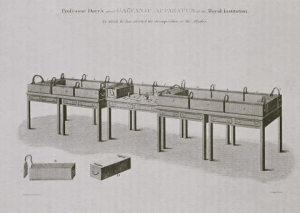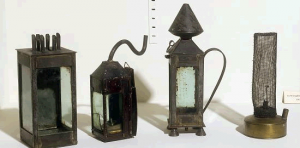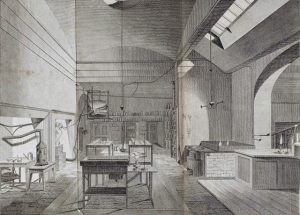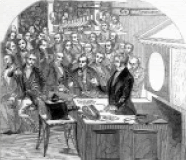The Royal Institution

- Davy’s safety lamp, and electric batteries
- [click on the picture to enlarge it]
The Royal Institution of Great Britain was founded in London in 1799 as an ’institution for diffusing the knowledge, and facilitating the general introduction, of useful mechanical inventions and improvements; and for teaching, by courses of philosophical lectures and experiments, the application to the purposes of common life.’

- Davy’s safety lamp, and electric batteries
- [click on the picture to enlarge it]
Its purpose was to promote the application of science to agriculture and industry; it was also to disseminate science to a wide public through lectures and demonstrations. The members were landowners, officers and members of Parliament as well as scientists and inventors such a Rumford; it was housed in Albemarle Street, where it has remained to this day, and where the laboratories with their scientific apparatus may be visited.

- The Chemical Laboratory in 1819
- Interior of the Laboratory of the Royal Institution
[click on the picture to enlarge it]
To carry out the demonstrations, the Royal Institution appointed Humphry Davy (1778-1822) in 1801; Davy has started his scientific experiments in Bristol, and in 1802 he became Professor of Chemistry. He is now famous for his invention of the miners’ safety lamp (1815-16). He recruited Faraday (1791-1867), an apprentice bookbinder who attended his lectures, as chemical assistant in 1813; Faraday became one of the best-known scientists of the Royal Institution.

- Lecture hall
- A later image (1846) showing the lecture hall during a demonstration by Faraday; the lecture hall dates from 1802.
[click on the picture to enlarge it]
The Royal Institution became a centre of experimentation, with a laboratory and a library. It also has a lecture hall for public demonstrations.
Its present PDA tour (tablet for the visitors) has a section on Rumford’s experiments which has served as a model for the interactive on gaslighting in this course.

